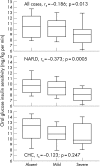Post-load insulin resistance is an independent predictor of hepatic fibrosis in virus C chronic hepatitis and in non-alcoholic fatty liver disease
- PMID: 17392334
- PMCID: PMC1954981
- DOI: 10.1136/gut.2006.107946
Post-load insulin resistance is an independent predictor of hepatic fibrosis in virus C chronic hepatitis and in non-alcoholic fatty liver disease
Abstract
Background: Insulin resistance is a significant risk factor for hepatic fibrosis in patients with both non-alcoholic fatty liver disease (NAFLD) and chronic hepatitis C (CHC), either directly or by favouring hepatic steatosis. Several methods are available to assess insulin resistance, but their impact on this issue has never been evaluated.
Aims: To determine the relative contribution of steatosis, metabolic abnormalities and insulin resistance, measured by different basal and post-load parameters, to hepatic fibrosis in CHC and in NAFLD patients.
Methods: In 90 patients with CHC and 90 pair-matched patients with NAFLD, the degree of basal insulin resistance (by the homeostasis model assessment, (HOMA)) and post-load insulin sensitivity (by the oral glucose insulin sensitivity (OGIS) index) was assessed, together with the features of the metabolic syndrome according to Adult Treatment Panel III definition. Data were correlated with hepatic histopathology.
Results: The prevalence of basal insulin resistance (HOMA values >75th percentile of normal) was 23.3% in CHC patients and 57.8% in NAFLD, but it increased to 28.8 and 67.8% when measured by post-load insulin resistance (OGIS <25th percentile). In a multivariate model, after adjustment for age, gender and body mass index, OGIS was a predictor of severe fibrosis in CHC and in NAFLD patients, independently of steatosis. An OGIS value below the cut-off of the 25th percentile increased the likelihood ratio of severe fibrosis by a factor of 1.5-2 and proved to be a more sensitive and generally more specific test than HOMA-R for the identification of subjects with severe fibrosis both in NAFLD and in CHC.
Conclusions: Post-load insulin resistance (OGIS <9.8 mg/kg/min) is associated with severe hepatic fibrosis in both NAFLD and CHC patients, and may help identify subjects at risk of progressive disease.
Conflict of interest statement
Competing interests. None declared.
Comment in
-
Differential relationships between basal and post-load insulin resistance indices and hepatic fibrosis in chronic hepatitis C and in non-alcoholic fatty liver disease.Gut. 2008 Mar;57(3):426; author reply 426-7. Gut. 2008. PMID: 18268061 No abstract available.
-
Beta-cell glucose sensitivity in patients with liver fibrosis.Gut. 2008 Jul;57(7):1023. Gut. 2008. PMID: 18559392 No abstract available.
Similar articles
-
Fibrosis in genotype 3 chronic hepatitis C and nonalcoholic fatty liver disease: Role of insulin resistance and hepatic steatosis.Hepatology. 2006 Dec;44(6):1648-55. doi: 10.1002/hep.21429. Hepatology. 2006. PMID: 17133473
-
Insulin resistance: a major factor associated with significant liver fibrosis in Egyptian patients with genotype 4 chronic hepatitis C.Eur J Gastroenterol Hepatol. 2013 Apr;25(4):421-7. doi: 10.1097/MEG.0b013e32835c9f69. Eur J Gastroenterol Hepatol. 2013. PMID: 23470266
-
Insulin resistance in chronic hepatitis C: association with genotypes 1 and 4, serum HCV RNA level, and liver fibrosis.Gastroenterology. 2008 Feb;134(2):416-23. doi: 10.1053/j.gastro.2007.11.010. Epub 2007 Nov 12. Gastroenterology. 2008. PMID: 18164296
-
Review article: non-alcoholic fatty liver disease and hepatitis C--risk factors and clinical implications.Aliment Pharmacol Ther. 2005 Nov;22 Suppl 2:48-51. doi: 10.1111/j.1365-2036.2005.02596.x. Aliment Pharmacol Ther. 2005. PMID: 16225473 Review.
-
Insulin resistance and metabolic syndrome in chronic liver diseases: old entities with new implications.Scand J Gastroenterol. 2009;44(1):6-14. doi: 10.1080/00365520802273058. Scand J Gastroenterol. 2009. PMID: 18661429 Review.
Cited by
-
Incidence of Type 2 Diabetes in Children With Nonalcoholic Fatty Liver Disease.Clin Gastroenterol Hepatol. 2023 May;21(5):1261-1270. doi: 10.1016/j.cgh.2022.05.028. Epub 2022 Jun 13. Clin Gastroenterol Hepatol. 2023. PMID: 35709934 Free PMC article.
-
Insulin resistance and necroinflammation drives ductular reaction and epithelial-mesenchymal transition in chronic hepatitis C.Gut. 2011 Jan;60(1):108-15. doi: 10.1136/gut.2010.219741. Epub 2010 Oct 21. Gut. 2011. PMID: 20966027 Free PMC article.
-
Comparative evaluation of whole body and hepatic insulin resistance using indices from oral glucose tolerance test in morbidly obese subjects with nonalcoholic Fatty liver disease.J Obes. 2010;2010:741521. doi: 10.1155/2010/741521. Epub 2010 Jun 8. J Obes. 2010. PMID: 20798875 Free PMC article.
-
Diabetes and Hepatitis C: A Two-Way Association.Front Endocrinol (Lausanne). 2015 Sep 14;6:134. doi: 10.3389/fendo.2015.00134. eCollection 2015. Front Endocrinol (Lausanne). 2015. PMID: 26441826 Free PMC article. Review.
-
HCV infection and cryptogenic cirrhosis are risk factors for hepatocellular carcinoma among Latinos in New York City.J Community Health. 2009 Dec;34(6):500-5. doi: 10.1007/s10900-009-9184-2. J Community Health. 2009. PMID: 19705261
References
-
- D'Souza R, Sabin C A, Foster G R. Insulin resistance plays a significant role in liver fibrosis in chronic hepatitis C and in the response to antiviral therapy. Am J Gastroenterol 20051001509–1515. - PubMed
Publication types
MeSH terms
LinkOut - more resources
Full Text Sources
Medical


